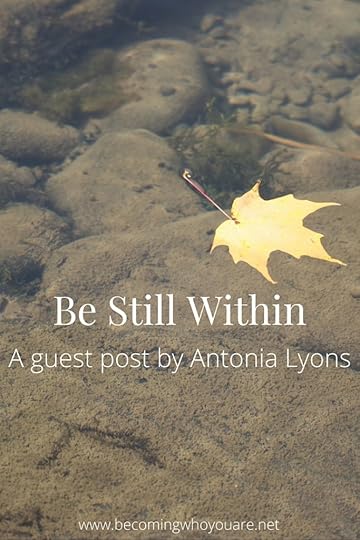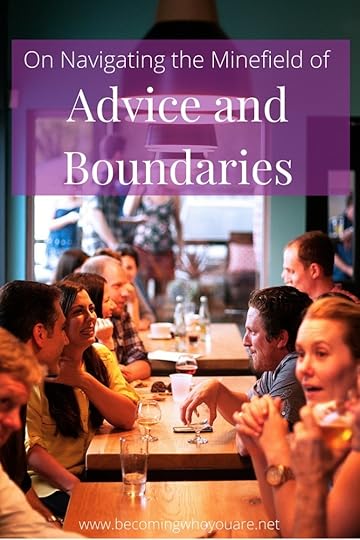Hannah Braime's Blog, page 18
June 13, 2016
How to Unhook from Digital Distractions
We spend more time online than ever before. According to this article, we’re now on the interwebs for twice as long each day as we were 10 years ago. This one reports the average American adult checks social media 17 times each day. So it’s not surprising I’ve heard from a few readers recently who’ve said one of their biggest challenges is around how to unhook from digital distractions so they can be present and engaged IRL.
I hear you, and it’s a tricky one. I am not a troglodyte: I love having wifi, a laptop and an iPhone. Having access to these things has improved my life in numerous ways. I’m grateful that I’m alive in a time where I can work online, and connect and stay in touch with people halfway across the globe. I have access to more books at my fingertips than in my local library. If I have a question about life, the universe, or anything, Google will (usually) provide.
But.
As with everything that is an integral part of our lives, we can get hooked. For many of us, the internet has fallen into the same category as food and money. These are things we use in our daily lives and depend on to exist as part of society. And because of this integration, unhooking is hard. If we want to unhook from things like alcohol, drugs or other common addictions, we have the choice to draw a bright line and go cold turkey. But for the things we use in our daily lives that come with great benefits, or (as in my case) rely on for our livelihood, quitting altogether isn’t an option.
How to Unhook from the Digital Distractions Internally
I spend the majority of my time online, so I’ve thought a lot about how to cultivate a healthy relationship with digital things over the last few years. By far and away the most helpful thing I’ve done to unhook from digital distractions isn’t a practical hack (although I will share some of those below). Instead, it involves internal accountability.
The first step is to get honest with myself and acknowledge I am misusing social media, email or the internet. Then, it’s time to get curious:
Why am I doing what I’m doing right now?
What am I trying to distract myself from?
How do I feel when I stop scrolling through Facebook and just sit and allow myself to experience what I’m feeling?
What am I craving right now? What need am I trying to meet here (this chart might be a useful point of reference)? Is this really meeting those needs? If not, what else is a better alternative?
More often than not, we want to feel valuable, wanted, liked, appreciated, connected. We get FOMO; we fear missing out on being part of something, being in the know, being included. These are human needs and fears, and they’re important to acknowledge. But the internet (and everything on it) isn’t the only—nor the most effective—way to meet these needs. Once we get acquainted with what’s really driving us, we can ask ourselves: what are my other alternatives for meeting this need right now?
How to Unhook from Digital Distractions Externally
N.B. This is something I talk more about with Clare Barry in this week’s podcast episode (coming Thursday). She shares some great insights and suggestions around disconnecting so, if this idea of unhooking resonates, I recommend checking it out.
1. Remove social media apps from your phone
I removed the Facebook and messenger apps last year, more due to security concerns than wanting digital space, and I haven’t missed them once. I’ve turned off push notifications for everything else that can become a crutch, including email, other social networks. That way, I get to engage with these things on my terms and in my time, rather than being at the whim of other people’s engagement.
2. Have a ‘switch on’ and ‘switch off’ time
I find my switch on and switch off times ebb and flow depending on what I’m working on and what my schedule is like. Whatever is happening in life, though, I refrain from checking email or social media before a certain point in my morning (usually after I’ve had a coffee, done some journaling, and done some kind of meditation or breathing exercise). It’s not a huge amount of time, but having that space allows me to start the day on my own terms, rather than reacting to external bids for attention and events (seeing a pattern here?)
Equally, I always read before I go to sleep—a physical book or a Kindle, not a screen. Most of us know blue light inhibits our sleep quality, so we need boundaries around phones and screens. Even little habits like leaving your laptop or phone outside the bedroom (or plugging them in on the other side of the room) can help.
3. Change your multiple browser window habit
Just before writing this sentence, I checked my browser and lo, there were 8 different tabs open. Given it’s 9am, and this is one of my first work-related activities this morning, it’s safe to say curbing my multiple tab use is a work in progress… As this article points out, having multiple tabs open isn’t good for us . It provides the illusion of productivity but actually makes us more scattered, affects our focus and memory and leaves us feeling more disengaged and distracted. Again, the most effective way I’ve found to combat this is to check in regularly and close anything I don’t need so it’s not taking up unnecessary attention.
4. Use technology to help
You and I are by no means the only people figuring out how to unhook from digital distractions, so there are plenty of tools out there designed to help. I don’t use these myself (so can’t vouch for them), but I’ve had friends, colleagues and clients who have found them very helpful.
A lot of these are designed for work but are just as useful for those times when you want to break the distraction habit, become more conscious of your behaviour, and spend your time on more fulfilling activities.Some of the most popular include Focus, Freedom, Self-Control, and Nanny.
5. Give yourself deliberate time to dillydally
Having said all the above, we don’t want to turn all digital downtime into an angsty, guilt-ridden experience, so I’m a big advocate of giving yourself deliberate time to enjoy it too. Allow yourself a window to go wild on Facebook, to roll around in email and immerse yourself in your online guilty pleasures. Having this time to enjoy it unhindered will make it much easier to be conscious about what you’re doing and why the rest of the time.
6. Replace your digital distraction with another activity
As with all habits, when we unhook from digital distractions the steps above are just part of the equation. We’re far more likely to succeed if we can fill that space with an alternative go-to activity. Find something wholesome and life-enriching you’ve been meaning to spend more time on or try and practice switching to that whenever you notice you’re mindlessly using digital distractions. Perhaps this is a good time to take up journaling, writing poetry, or working through The Artist’s Way?
Your challenge: Get curious with yourself about your digital distraction using the questions above and stay open to what comes up.
How do you unhook from digital distractions? Leave a comment and share your thoughts.
Further reading: How to overcome FOMO & 9 simple suggestions for blissful self-care during winter
Image: Death to the Stock Photo
The post How to Unhook from Digital Distractions appeared first on Becoming Who You Are.









June 9, 2016
Identifying and Changing Life Patterns
This is a guest post by Orsolya Hernold.
The habit of writing a journal and the frequent re-reading of my notes helped me to identify my life patterns. Realizing that I am just about to weave another of the good old fabric of my life enabled me to change patterns I didn’t wish to repeat. A life pattern for me can be inherited or imprinted from parents or a repeated way of decision making. I will now share with you some of my repetitions and invite you to investigate your life from this aspect.
I am quite a restless person – I left both high school and university after two years, choosing to spend some time abroad instead. The maximum time I have spent at a workplace has been two years. We, as a family, move a lot. My son will have his 8th birthday in his 6th home.
I easily get excited and enthusiastic about a project, then I can quickly drop the idea – a pattern I would like to un-weave with this blog. I intend to be persistent with it for at least a year.
Doing everything fast and effective is a definite inheritance – serving me well a lot of times, but also frequently making myself overwhelmed and exhausted. So I strive to create a balance here: productivity in housework and at work is desirable, but I watch for the signs of stress. And I am building a “relaxed mode Orsi” for times with Zoli and the children, as well as on holidays and at weekends.
I’m far better doing things the second time. I have failed a number of times at doing something for the first time (I just read my first swimming competition, where I got the whole team disqualified with an ill-timed jump), but I have got up (many times with the help of others) and redone it again, where I have then succeeded. I realized a couple of years ago that this pattern is not valid anymore: my first born is just as perfect as my second born, have I told you already? Besides this very important example, I managed several projects as a consultant where I was new to the industry and the company, yet I delivered on time and in good quality.
I fell in love with the same kind of guys for a long time – a pattern that was the hardest to figure out and undo.
>>" width="400" height="600" srcset="http://www.becomingwhoyouare.net/wp-c... 683w, http://www.becomingwhoyouare.net/wp-c... 200w, http://www.becomingwhoyouare.net/wp-c... 735w" sizes="(max-width: 400px) 100vw, 400px" />
Now you have a picture of what I am talking about when referring to life patterns – anything that is repeatedly happening in your life. Get some paper or a file open and jot down yours:
Can I recall any repetition in my life? With people, at work, at home, in habits or in decisions?
With regard to each identified repetition, ask: has repeatedly doing this served my life so far?
Is there a pattern I wish to finish and not repeat anymore?
What can or would I like to change to enable myself to un-weave this piece of fabric in my life?
Who can I ask to support me in this change?
If you decide to change something, then try to make a plan. I have a weekly target and also long term goals to reach with my blog, all of which I return to daily. This plan (with the great feedback from readers) helps me to stay focused on changing my pattern of “quickly losing heart,” as well as ensuring that I keep my zeal.
What have you found useful for identifying your life patterns? Leave a comment and share your thoughts.
About Orsolya

Orsolya is a coach and trainer from Budapest, Hungary, where she lives with her partner Zoli and two children. She has been writing about herself for more than 20 years and shares her journey of personal growth, self-improvement and growing consciousness through her website, orzola.org. Follow her bio-monthly online journaling course, or find her on Twitter @OrzolaJournal or Facebook.
Image: Judson Moore
The post Identifying and Changing Life Patterns appeared first on Becoming Who You Are.









June 6, 2016
How to Start a Daily Journaling Practice
Newsflash: journaling is really, really good for you. But no matter how much we know this, putting pen to paper (or fingers to keyboard) on a daily basis can be challenge. I hear from so many of you who know a daily journaling practice could be useful but struggle to stick to a regular commitment.
As with most things of this nature, the simplest advice is: just start. As humans, we have an astonishing capacity to overcomplicate things when the easiest way forward is just to do it. And not tomorrow, today. Right now, if possible. Here are a few things I’ve also found helpful in maintaining my own daily journaling practice, plus a year’s worth of journaling prompts you can use to kickstart your journaling today:
Set intentions
Why do you want to journal right now? What are you hoping to get out of a regular practice? There is no “right” answer to this question and your intentions and desires will be personal to you. It’s helpful to think about this now though, because your intentions will inform the decisions you make regarding the following points.
Decide on a time for your daily journaling practice
I’ve found early in the morning is easiest because once it’s done it’s done and I don’t have to remember to do it later in the day. Things we leave until the evening tend to get bypassed in favour of other commitments, low energy and depleted willpower. But again, your intention will influence this. If you’re looking to improve your sleep hygiene and think journaling could help you clear your mind before bed, the evening will be ideal.
As well as a time, designate a journaling spot so you get used to writing in the same place at the same time each day. The more you can do this, the more routine it will become and the easier it will be to maintain a daily journaling practice. After enough repetition, our brains find it easier to switch from external focus to internal focus upon certain cues. Sitting down in the same place at approximately the same time each day to journal counts as two of those cues.
Decide on a structure
What are you going to write about? Play around with different kinds of journaling and decide in advance what your style du jour will be. If you need some inspiration, check out the 52 journaling prompts at the bottom of this post or read more about one of my favourite journaling techniques, morning pages. You don’t have to stick with the same structure day in, day out (I tend to switch depending on what feels most useful at the time), but choosing a set of prompts or a certain style before you start will make sitting down to write easier.
Start small
If you’re new to journaling, start by setting a timer for 10-15 minutes and writing. Week by week, work your way up from there. This isn’t a race or competition, there’s no rush, and you’re likely to find it a lot easier to stick to a daily journaling practice if you start slow and find your rhythm.
Incentivise yourself
When you get clear on why you want to journal, you’ll already have some incentive. But some of us also find external motivation helpful. That’s why I periodically return to using 750words.com. I like the statistics, the badges, and the fact you can keep track of your streak. Reflect on what motivates you (perhaps this could make a fruitful journaling session). Is it something similar to the stats and badges I just mentioned? Public accountability? A buddy or partner you can check in with? Finding different ways to make it fun? Figure out your style and incorporate some of those elements into your practice.
Give yourself permission to be imperfect
Blank pages and screens are your friend, not your enemy. Let go of any expectations or ideals of how you “should” be journaling and just focus on starting. Remember there is no right or wrong way to journal. No one is going to come along and start grading you on grammar, spelling and style so it doesn’t matter if it’s good, bad, ugly or plain cringe-worthy.
Our inner critics can be one of the biggest obstacles we face with a daily journaling practice. If yours pops up, use the opportunity to start a dialogue with this internal voice. Ask it: what’s on his or her mind? Why is it trying to get you to stop doing this? What is it afraid of? What is it trying to protect you from? Investigate these questions and you’ll have a better idea of what’s driving your inner critic, plus how you can negotiate with this part of your internal dialogue going forward.
What have you found most helpful when maintaining a daily journaling practice? Leave a comment and share your thoughts!
Further reading: The Ultimate Guide to Journaling & Journaling: getting in the zone
Get a Year's Worth of Journaling Prompts
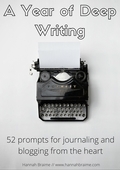
Enter your email to download a year's worth of prompts for blogging and journaling.
You'll also get access to all the other workbooks, video classes and MP3s in the Becoming Who You Are Library, plus weekly updates on living with greater courage, compassion and authenticity.
Success! Please check your inbox and click the link in the confirmation email to download your workbook.
There was an error submitting your subscription. Please try again.
First Name Email Address I'd like to receive the free email course. Download Powered by ConvertKit /* Layout */ .ck_form { /* divider image */ background: #fff url(data:image/gif;base64,R0lGODlhAQADAIABAMzMzP///yH/C1hNUCBEYXRhWE1QPD94cGFja2V0IGJlZ2luPSLvu78iIGlkPSJXNU0wTXBDZWhpSHpyZVN6TlRjemtjOWQiPz4gPHg6eG1wbWV0YSB4bWxuczp4PSJhZG9iZTpuczptZXRhLyIgeDp4bXB0az0iQWRvYmUgWE1QIENvcmUgNS41LWMwMTQgNzkuMTUxNDgxLCAyMDEzLzAzLzEzLTEyOjA5OjE1ICAgICAgICAiPiA8cmRmOlJERiB4bWxuczpyZGY9Imh0dHA6Ly93d3cudzMub3JnLzE5OTkvMDIvMjItcmRmLXN5bnRheC1ucyMiPiA8cmRmOkRlc2NyaXB0aW9uIHJkZjphYm91dD0iIiB4bWxuczp4bXA9Imh0dHA6Ly9ucy5hZG9iZS5jb20veGFwLzEuMC8iIHhtbG5zOnhtcE1NPSJodHRwOi8vbnMuYWRvYmUuY29tL3hhcC8xLjAvbW0vIiB4bWxuczpzdFJlZj0iaHR0cDovL25zLmFkb2JlLmNvbS94YXAvMS4wL3NUeXBlL1Jlc291cmNlUmVmIyIgeG1wOkNyZWF0b3JUb29sPSJBZG9iZSBQaG90b3Nob3AgQ0MgKE1hY2ludG9zaCkiIHhtcE1NOkluc3RhbmNlSUQ9InhtcC5paWQ6MUQ5NjM5RjgxQUVEMTFFNEJBQTdGNTQwMjc5MTZDOTciIHhtcE1NOkRvY3VtZW50SUQ9InhtcC5kaWQ6MUQ5NjM5RjkxQUVEMTFFNEJBQTdGNTQwMjc5MTZDOTciPiA8eG1wTU06RGVyaXZlZEZyb20gc3RSZWY6aW5zdGFuY2VJRD0ieG1wLmlpZDoxRDk2MzlGNjFBRUQxMUU0QkFBN0Y1NDAyNzkxNkM5NyIgc3RSZWY6ZG9jdW1lbnRJRD0ieG1wLmRpZDoxRDk2MzlGNzFBRUQxMUU0QkFBN0Y1NDAyNzkxNkM5NyIvPiA8L3JkZjpEZXNjcmlwdGlvbj4gPC9yZGY6UkRGPiA8L3g6eG1wbWV0YT4gPD94cGFja2V0IGVuZD0iciI/PgH//v38+/r5+Pf29fTz8vHw7+7t7Ovq6ejn5uXk4+Lh4N/e3dzb2tnY19bV1NPS0dDPzs3My8rJyMfGxcTDwsHAv769vLu6ubi3trW0s7KxsK+urayrqqmop6alpKOioaCfnp2cm5qZmJeWlZSTkpGQj46NjIuKiYiHhoWEg4KBgH9+fXx7enl4d3Z1dHNycXBvbm1sa2ppaGdmZWRjYmFgX15dXFtaWVhXVlVUU1JRUE9OTUxLSklIR0ZFRENCQUA/Pj08Ozo5ODc2NTQzMjEwLy4tLCsqKSgnJiUkIyIhIB8eHRwbGhkYFxYVFBMSERAPDg0MCwoJCAcGBQQDAgEAACH5BAEAAAEALAAAAAABAAMAAAICRFIAOw==) repeat-y center top; font-family: "Helvetica Neue", Helvetica, Arial, Verdana, sans-serif; line-height: 1.5em; overflow: hidden; color: #000000; font-size: 16px; border-top: solid 20px #3071b0; border-top-color: #9a349a; border-bottom: solid 10px #3d3d3d; border-bottom-color: #5c1f5c; -webkit-box-shadow: 0px 0px 5px rgba(0,0,0,.3); -moz-box-shadow: 0px 0px 5px rgba(0,0,0,.3); box-shadow: 0px 0px 5px rgba(0,0,0,.3); clear: both; margin: 20px 0px; } .ck_form, .ck_form * { -webkit-box-sizing: border-box; -moz-box-sizing: border-box; box-sizing: border-box; } #ck_subscribe_form { clear: both; } /* Element Queries — uses JS */ .ck_form_content, .ck_form_fields { width: 50%; float: left; padding: 5%; } .ck_form.ck_horizontal { } .ck_form_content { border-bottom: none; } .ck_form.ck_vertical { background: #fff; } .ck_vertical .ck_form_content, .ck_vertical .ck_form_fields { padding: 10%; width: 100%; float: none; } .ck_vertical .ck_form_content { border-bottom: 1px dotted #aaa; overflow: hidden; } /* Trigger the vertical layout with media queries as well */ @media all and (max-width: 499px) { .ck_form { background: #fff; } .ck_form_content, .ck_form_fields { padding: 10%; width: 100%; float: none; } .ck_form_content { border-bottom: 1px dotted #aaa; } } /* Content */ .ck_form_content h3 { margin: 0px 0px 15px; font-size: 24px; padding: 0px; } .ck_form_content p { font-size: 14px; } .ck_image { float: left; margin-right: 5px; } /* Form fields */ .ck_errorArea { display: none; } #ck_success_msg { padding: 10px 10px 0px; border: solid 1px #ddd; background: #eee; } .ck_label { font-size: 14px; font-weight: bold; } .ck_form input[type="text"], .ck_form input[type="email"] { font-size: 14px; padding: 10px 8px; width: 100%; border: 1px solid #d6d6d6; /* stroke */ -moz-border-radius: 4px; -webkit-border-radius: 4px; border-radius: 4px; /* border radius */ background-color: #f8f7f7; /* layer fill content */ margin-bottom: 5px; height: auto; } .ck_form input[type="text"]:focus, .ck_form input[type="email"]:focus { outline: none; border-color: #aaa; } .ck_checkbox { padding: 10px 0px 10px 20px; display: block; clear: both; } .ck_checkbox input.optIn { margin-left: -20px; margin-top: 0; } .ck_form .ck_opt_in_prompt { margin-left: 4px; } .ck_form .ck_opt_in_prompt p { display: inline; } .ck_form .ck_subscribe_button { width: 100%; color: #fff; margin: 10px 0px 0px; padding: 10px 0px; font-size: 18px; background: #9a349a; -moz-border-radius: 4px; -webkit-border-radius: 4px; border-radius: 4px; /* border radius */ cursor: pointer; border: none; text-shadow: none; } .ck_form .ck_guarantee { color: #626262; font-size: 12px; text-align: center; padding: 5px 0px; display: block; } .ck_form .ck_powered_by { display: block; color: #aaa; } .ck_form .ck_powered_by:hover { display: block; color: #444; } .ck_converted_content { display: none; padding: 5%; background: #fff; }>> | www.becomingwhoyouare.net" width="400" height="600" srcset="http://www.becomingwhoyouare.net/wp-c... 683w, http://www.becomingwhoyouare.net/wp-c... 200w, http://www.becomingwhoyouare.net/wp-c... 735w" sizes="(max-width: 400px) 100vw, 400px" />
The post How to Start a Daily Journaling Practice appeared first on Becoming Who You Are.









June 4, 2016
#96: Overcoming People-Pleasing and Creating Healthy Boundaries with Amy E. Smith
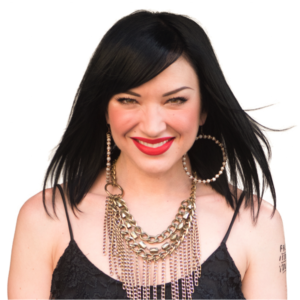 In this episode I’m talking to the lovely Amy E. Smith about creating healthy boundaries, people-pleasing and how both of these things start with our own sense of worthiness.
In this episode I’m talking to the lovely Amy E. Smith about creating healthy boundaries, people-pleasing and how both of these things start with our own sense of worthiness.
Amy is a certified confidence coach, masterful speaker, and personal empowerment expert. Founder of TheJoyJunkie.com, Amy uses her roles as coach, writer, podcaster, and speaker to move individuals to a place of radical personal empowerment and self-love. With acute focus on helping people “find their voice”, she is highly sought after for her uncommon style of irreverence, wisdom, and humor and has been a featured expert on Fox 5 San Diego and YourTango.com.
Episode: Overcoming People-Pleasing and Creating Healthy Boundaries with Amy E. Smith
Topics we cover include:
Some of the most common misconceptions around what boundaries are (and the truth behind them)
Amy’s 3-step system for establishing clear boundaries
A useful visualisation for unhooking from what other people think
A powerful question we can ask ourselves whenever we’re struggling to express our boundaries
How we can bring the unconscious beliefs that stop us communicating boundaries to light (including beliefs around worthiness and being enough)
…and much more!
Share the Wisdom
You can truly be in opposition with somebody and speak up for yourself, and do it with kindness.
Click To Tweet
In order to change any belief, the first step is always to question it. – @thejoyjunkie
Click To Tweet
We start to feel enough when we separate out our human experience from our sense of worthiness.
Click To Tweet
When it comes to boundaries, you are responsible for your intention, not your reception.
Click To Tweet
Useful Links
Rising Strong by Brené Brown
The Joy Junkie Show
Amy’s free workbook: How to Stand Up for Yourself Without Being a D***
Say Hello
Amy
Instagram: @thejoyjunkie
Facebook: facebook.com/thejoyjunkie
Website: thejoyjunkie.com
Hannah
Twitter: @hannahbraime
Facebook: facebook.com/becomingwhoyouare
Website: becomingwhoyouare.net
Subscribe to the Podcast
Intro and outro: Stephanie Murphy
Image: Brooke Cagle via Unsplash
>> | www.becomingwhoyouare.net" width="683" height="1024" class="alignleft size-large wp-image-11691" srcset="http://www.becomingwhoyouare.net/wp-c... 683w, http://www.becomingwhoyouare.net/wp-c... 200w, http://www.becomingwhoyouare.net/wp-c... 735w" sizes="(max-width: 683px) 100vw, 683px" />
The post #96: Overcoming People-Pleasing and Creating Healthy Boundaries with Amy E. Smith appeared first on Becoming Who You Are.










May 30, 2016
10 Lessons from ‘Succeed’ by Heidi Grant Halvorson
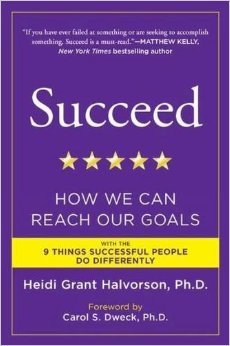 We all have goals. Even if you have icky connotations with the word goals, chances are you almost certainly have things you want to experience and do during your life (in the interests of brevity, let’s just call them “goals” for now).
We all have goals. Even if you have icky connotations with the word goals, chances are you almost certainly have things you want to experience and do during your life (in the interests of brevity, let’s just call them “goals” for now).
Real-talk time: there is a lot of nonsense out there about what it takes to succeed at our goals. Google it and weep.
At one extreme, there’s the uber masculine “Get up at 4am, crush it and keep crushing it until everyone else has given up and you’re the only one left on the playing field because that’s the only one you’re going to succeed” all-caps rant that usually ends in a lot of exclamation points. At the other extreme, there’s the woo-woo “Write yourself a cheque for $1,000,000, put it in your wallet, and watch the magic happen” approach that substitutes wishful thinking and good intentions for actually, you know, doing stuff.
Personally, I opt for something in the middle. I’m not adverse to hard work and I don’t believe thinking your way to success is enough (also, who writes cheques anymore?), but I also value freedom, self-care, and don’t want to end up having a nervous breakdown because I’m in ceaseless competition with everyone around me the whole time. Nope.
Heidi Grant Halvorson is a social psychologist who researches and writes about topics like focus and success. In Succeed: How We Can Reach Our Goals, she outlines key strategies and mindsets we can use to get better at achieving what we want in any area of life, whether we’re focusing on a big work project, running a marathon, or seeking a new relationship.
I’ve read quite a few positive psychology books in the past and have found them to be superficial, overhyped and not particularly helpful (this one and this one were exceptions). What I like about Succeed is it doesn’t contain empty advice like “Just decide to be happy” (um, if that were all it took, wouldn’t we have done that by now?) nor does it delve into the kind of territory a lot of success-related books repeat ad nauseum (see the two extremes mentioned above).
Instead, Heidi translates a ton of research into practical takeaways that we can all use in our daily lives. What’s more, a lot of the findings run counter to conventional wisdom about setting and achieving goals (like the section where she explains how visualising ourselves succeeding at a particular goal is more of a hindrance than a help—and what we should do instead). As a recovering perfectionist, one of my biggest a-ha moments was the idea that we achieve more—and have a better time doing it—when we stop focusing on “being good” and start focusing on “getting better.”
Among other things, she covers topics like how to choose goals that are most likely to motivate you internally, how to think about your goals in order to succeed, and how to know when it’s time to give up on a goal. I picked up a few useful ideas from this book that I’m certainly using going forward. If this topic interests you, I hope you’ll check it out!
Further reading: Are your goals helping or hurting you? & how to balance goals and self-care
>> | www.becomingwhoyouare.net" width="683" height="1024" srcset="http://www.becomingwhoyouare.net/wp-c... 683w, http://www.becomingwhoyouare.net/wp-c... 200w, http://www.becomingwhoyouare.net/wp-c... 735w" sizes="(max-width: 683px) 100vw, 683px" />
Get your summary of 'Succeed' by Heidi Grant Halvorson 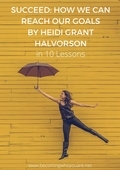
Enter your email to get your copy of Succeed: How We Can Reach Our Goals by Heidi Grant Halvorson in 10 Lessons.
You'll also get access to the other workbooks and MP3s in the Becoming Who You Are Library, plus weekly updates on living with greater courage, compassion and authenticity.
Success! Please check your inbox and click the link in the confirmation email to download your workbook.
There was an error submitting your subscription. Please try again.
First Name Email Address I'd like to receive the free email course. Download Powered by ConvertKit /* Layout */ .ck_form { /* divider image */ background: #fff url(data:image/gif;base64,R0lGODlhAQADAIABAMzMzP///yH/C1hNUCBEYXRhWE1QPD94cGFja2V0IGJlZ2luPSLvu78iIGlkPSJXNU0wTXBDZWhpSHpyZVN6TlRjemtjOWQiPz4gPHg6eG1wbWV0YSB4bWxuczp4PSJhZG9iZTpuczptZXRhLyIgeDp4bXB0az0iQWRvYmUgWE1QIENvcmUgNS41LWMwMTQgNzkuMTUxNDgxLCAyMDEzLzAzLzEzLTEyOjA5OjE1ICAgICAgICAiPiA8cmRmOlJERiB4bWxuczpyZGY9Imh0dHA6Ly93d3cudzMub3JnLzE5OTkvMDIvMjItcmRmLXN5bnRheC1ucyMiPiA8cmRmOkRlc2NyaXB0aW9uIHJkZjphYm91dD0iIiB4bWxuczp4bXA9Imh0dHA6Ly9ucy5hZG9iZS5jb20veGFwLzEuMC8iIHhtbG5zOnhtcE1NPSJodHRwOi8vbnMuYWRvYmUuY29tL3hhcC8xLjAvbW0vIiB4bWxuczpzdFJlZj0iaHR0cDovL25zLmFkb2JlLmNvbS94YXAvMS4wL3NUeXBlL1Jlc291cmNlUmVmIyIgeG1wOkNyZWF0b3JUb29sPSJBZG9iZSBQaG90b3Nob3AgQ0MgKE1hY2ludG9zaCkiIHhtcE1NOkluc3RhbmNlSUQ9InhtcC5paWQ6MUQ5NjM5RjgxQUVEMTFFNEJBQTdGNTQwMjc5MTZDOTciIHhtcE1NOkRvY3VtZW50SUQ9InhtcC5kaWQ6MUQ5NjM5RjkxQUVEMTFFNEJBQTdGNTQwMjc5MTZDOTciPiA8eG1wTU06RGVyaXZlZEZyb20gc3RSZWY6aW5zdGFuY2VJRD0ieG1wLmlpZDoxRDk2MzlGNjFBRUQxMUU0QkFBN0Y1NDAyNzkxNkM5NyIgc3RSZWY6ZG9jdW1lbnRJRD0ieG1wLmRpZDoxRDk2MzlGNzFBRUQxMUU0QkFBN0Y1NDAyNzkxNkM5NyIvPiA8L3JkZjpEZXNjcmlwdGlvbj4gPC9yZGY6UkRGPiA8L3g6eG1wbWV0YT4gPD94cGFja2V0IGVuZD0iciI/PgH//v38+/r5+Pf29fTz8vHw7+7t7Ovq6ejn5uXk4+Lh4N/e3dzb2tnY19bV1NPS0dDPzs3My8rJyMfGxcTDwsHAv769vLu6ubi3trW0s7KxsK+urayrqqmop6alpKOioaCfnp2cm5qZmJeWlZSTkpGQj46NjIuKiYiHhoWEg4KBgH9+fXx7enl4d3Z1dHNycXBvbm1sa2ppaGdmZWRjYmFgX15dXFtaWVhXVlVUU1JRUE9OTUxLSklIR0ZFRENCQUA/Pj08Ozo5ODc2NTQzMjEwLy4tLCsqKSgnJiUkIyIhIB8eHRwbGhkYFxYVFBMSERAPDg0MCwoJCAcGBQQDAgEAACH5BAEAAAEALAAAAAABAAMAAAICRFIAOw==) repeat-y center top; font-family: "Helvetica Neue", Helvetica, Arial, Verdana, sans-serif; line-height: 1.5em; overflow: hidden; color: #000000; font-size: 16px; border-top: solid 20px #3071b0; border-top-color: #9a349a; border-bottom: solid 10px #3d3d3d; border-bottom-color: #5c1f5c; -webkit-box-shadow: 0px 0px 5px rgba(0,0,0,.3); -moz-box-shadow: 0px 0px 5px rgba(0,0,0,.3); box-shadow: 0px 0px 5px rgba(0,0,0,.3); clear: both; margin: 20px 0px; } .ck_form, .ck_form * { -webkit-box-sizing: border-box; -moz-box-sizing: border-box; box-sizing: border-box; } #ck_subscribe_form { clear: both; } /* Element Queries — uses JS */ .ck_form_content, .ck_form_fields { width: 50%; float: left; padding: 5%; } .ck_form.ck_horizontal { } .ck_form_content { border-bottom: none; } .ck_form.ck_vertical { background: #fff; } .ck_vertical .ck_form_content, .ck_vertical .ck_form_fields { padding: 10%; width: 100%; float: none; } .ck_vertical .ck_form_content { border-bottom: 1px dotted #aaa; overflow: hidden; } /* Trigger the vertical layout with media queries as well */ @media all and (max-width: 499px) { .ck_form { background: #fff; } .ck_form_content, .ck_form_fields { padding: 10%; width: 100%; float: none; } .ck_form_content { border-bottom: 1px dotted #aaa; } } /* Content */ .ck_form_content h3 { margin: 0px 0px 15px; font-size: 24px; padding: 0px; } .ck_form_content p { font-size: 14px; } .ck_image { float: left; margin-right: 5px; } /* Form fields */ .ck_errorArea { display: none; } #ck_success_msg { padding: 10px 10px 0px; border: solid 1px #ddd; background: #eee; } .ck_label { font-size: 14px; font-weight: bold; } .ck_form input[type="text"], .ck_form input[type="email"] { font-size: 14px; padding: 10px 8px; width: 100%; border: 1px solid #d6d6d6; /* stroke */ -moz-border-radius: 4px; -webkit-border-radius: 4px; border-radius: 4px; /* border radius */ background-color: #f8f7f7; /* layer fill content */ margin-bottom: 5px; height: auto; } .ck_form input[type="text"]:focus, .ck_form input[type="email"]:focus { outline: none; border-color: #aaa; } .ck_checkbox { padding: 10px 0px 10px 20px; display: block; clear: both; } .ck_checkbox input.optIn { margin-left: -20px; margin-top: 0; } .ck_form .ck_opt_in_prompt { margin-left: 4px; } .ck_form .ck_opt_in_prompt p { display: inline; } .ck_form .ck_subscribe_button { width: 100%; color: #fff; margin: 10px 0px 0px; padding: 10px 0px; font-size: 18px; background: #9a349a; -moz-border-radius: 4px; -webkit-border-radius: 4px; border-radius: 4px; /* border radius */ cursor: pointer; border: none; text-shadow: none; } .ck_form .ck_guarantee { color: #626262; font-size: 12px; text-align: center; padding: 5px 0px; display: block; } .ck_form .ck_powered_by { display: block; color: #aaa; } .ck_form .ck_powered_by:hover { display: block; color: #444; } .ck_converted_content { display: none; padding: 5%; background: #fff; }Image: Edu Lauton
The post 10 Lessons from ‘Succeed’ by Heidi Grant Halvorson appeared first on Becoming Who You Are.









May 26, 2016
Be Still Within
This is a guest post from Antonia Lyons of Evoking Grace.
Lately I have committed to carve mini breaks out of my routine to allow my mind and soul regenerate from the business of everyday life.
It’s been soothing to my heart having the luxury of doing nothing during those quiet moments! I just really wanted to sit there and allow life to unfold. “Yes Universe, I know you need me, but you are going to have to wait cause I’m busy doing nothing now.” Geez it felt so good being able to tell the world to call back because I was enjoying the peace in my mind so much.
Then the other day something shifted and for the first time I got why some folks dread working in a quiet environment and they’d rather listen to their music than enjoying the silence.
As I sat on my yoga mat enjoying a good long stretch, I sensed a vast space all around me. So much of it, it could literally have swallowed me in.
I suddenly realized that the last couple of days I have been quieter than usual, my thinking has slowed down and somehow I have managed to get an incredible amount of work done in a very short time. I noticed that while I’d usually panic about meeting the various dead lines, somehow there is now a nice flow of energy sustaining me most of the time, which allows me to be productive and really enjoy whatever I’m creating.
This is all very new to me, and while I have allowed myself to “feel” life as I move through my day, the openness around me now starts feeling too wide and out of the blue I worry I may not know anymore what to do with myself.
The stillness within me and all around me now appears threatening, as if there may not be way back from the nothingness that I have slowly been able to touch.
My first reaction is to reach for my phone, check if I have got any emails or texts in the meanwhile. “Hello? Someone out there still loves me? Anyone?”
But as I hold my phone I know a part of me wants to stay in that quiet space, wants to breathe it all in and surrender to whatever unfolds in the unknown.
So I let myself lay on the mat, looking for support under my body, and I suddenly start to cry because I don’t want to move and because I sense my heart expanding in a way I never knew possible. And I love the spaciousness so much I don’t want to let it go, ever! And I know now that the nothingness is where we all come from, we all belong to and are all full of without even realizing it.
We spend our time running from something or someone, only to realize that it’s ourselves we are running from ’cause we’ve been told that what’s out there is better than what we’ll ever be. And we believed that.
So when we finally reach the immensity within ourselves, we freak out for we don’t feel we have enough to fill the void.
But enough we are and nothing else is needed in that space where we merge with all that is.
Later on that evening I can’t help noticing how refreshed I feel despite working in the small hours. But I feel so present and so supported by the hand I got to hold earlier on, I now know that I will never be alone in the stillness within me.
‘I know I will never be alone in the stillness within me.’ – @evokinggrace
Click To Tweet
And you, have you ever touched the nothing at the heart of everything? And if you have, how did you feel? Were you scared? Did you embrace it, wanting more? Did you fill it up with noise for the void felt too big?
About Antonia
 I’m the founder of Evoking Grace, a coaching program designed to inspire others to be their very best while bringing ease and balance into their everyday life. I can be contacted by email for more details on the work I offer or to schedule a free “Wisdom Within Session“. Follow my mumbling & musings on Facebook , Twitter & Pinterest to be part of my “online tribe”.
I’m the founder of Evoking Grace, a coaching program designed to inspire others to be their very best while bringing ease and balance into their everyday life. I can be contacted by email for more details on the work I offer or to schedule a free “Wisdom Within Session“. Follow my mumbling & musings on Facebook , Twitter & Pinterest to be part of my “online tribe”.
Image: Izabela Monick
Would you like to submit a guest post to Becoming Who You Are? Read the guidelines here.
The post Be Still Within appeared first on Becoming Who You Are.









May 23, 2016
Struggling With Confidence? These 5 Truths Might Help
I started my personal growth journey in therapy. When I first walked into that office, I was struggling with confidence (among other things) and I envisioned walking out again 3-6 months later with a state of unflappable inner peace, self-assuredness, and certainty around the big questions I was grappling with.
I soon learned—and am still learning—that this is a big old myth. Yes, there are plenty of gurus and self-described enlightened people who might say this is what we should strive for (Never feeling anger! Zero judgements of other people! Detachment from everything!) but let’s be real: it’s bullshihtzu.
I’m happier when I acknowledge that, at times, I struggle. I have those “Who am I to be doing this?” thoughts. I have days where I doubt myself and what I’m doing. I get vulnerability hangovers. I like to be in control (and will give the side-eye to anyone who says uncertainty is a necessary part of life, even though I know—sigh—they’re right.).
And I’ve learned I can have these experiences and still experience confidence—and that’s called being human. At any point, we’re all sitting somewhere on the confidence continuum.
Confidence is a process and a work in progress, not a permanent state of being.
I used to think of confidence like a light switch. With the right formula and the right ingredients, I could flick that switch to “on” and never have to worry about struggling with confidence again. But confidence is something we nurture and, although there are plenty of things we can do to enhance the level of confidence we experience in our lives, it’s something that ebbs and flows for all of us.
Expecting ourselves to feel 100% confidence all the time becomes a vicious cycle, because when we start struggling with confidence, we begin doubt ourselves even more. Instead, think of your confidence like a series of waves—we get to influence how big the peaks and troughs become, but a cyclical flow is natural.
Confidence comes from action (not the other way around)
Nonono. If I had a pound for every time I heard someone say “I want to do X, but I need to feel more confident first,” I would be writing this from my luxury cat sanctuary in Bora Bora right now.
This is one of the biggest misbeliefs about confidence out there and, if there’s one thing to take away from this article, it’s this: confidence comes from action, not the other way around.
I will repeat that because it’s important and it can take a while to digest:
Confidence results from action, it’s not a pre-requisite for taking action. The idea that we need to feel confident before we can do that thing we really want to do is a clever justification for staying comfortable and keeping ourselves small.
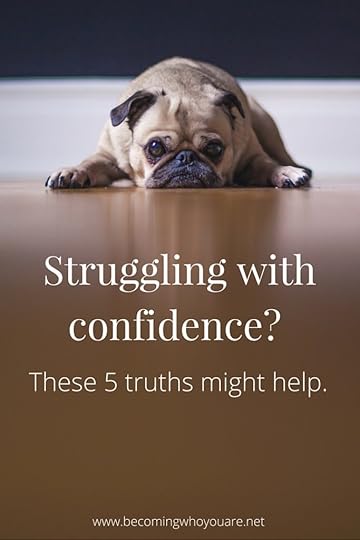
Arrogance is the opposite of confidence
Many people want more confidence, yet they fear crossing the line into arrogance and alienating the people around them. In reality, if you’re worried about appearing arrogant, chances are you’re fine because people who emanate arrogance don’t tend to worry about it.
Arrogance often masquerades as confidence, but it’s a thin shell of inflated sense of self-importance hiding deep-rooted insecurities underneath. When we work with the basic belief “Confident person = good person, unconfident person = bad person,” we’re a lot more likely to, borrowing a popular phrase, “Fake it ‘till we make it.” Making it in this context involves getting other people around us to believe we’re confident too, regardless of how we feel deep down.
Confidence is rooted in growth towards and belief in our capability to be the best version of ourselves. Arrogance is rooted in avoiding uncomfortable feelings and truths about ourselves.
As psychologist and author Amy Cuddy says in her TED talk on body language, a better alternative is “Fake it ‘till we become it.” Arrogance is rooted in appearances and power plays, confidence is rooted in how we feel about ourselves.
True confidence involves acknowledging we don’t always feel confident, that we’re not always right or the best, and feeling at peace with that. When we are confident, we have nothing to prove because knowing that for ourselves is enough.
Struggling with confidence isn’t a reflection of your abilities
Something I often tell clients is “just because we think something about ourselves doesn’t mean it’s true.” While it’s true that sometimes a lack of confidence can be an indicator we need to brush up on our skills or experience, more often than not there’s something (or things) else affecting how we feel.
Our self-concept, experiences we’ve had in the past, childhood messages, our evolutionary wiring (thanks, lizard brain), whether we’re in victim or creator mode, our feelings of worthiness and deserving… all of those things can present as “I can’t do this,” but that’s not reality. Our levels of confidence aren’t necessarily reflective of our abilities, which is why it’s also important to look for the evidence we can do the task at hand.
One way to tell if your confidence is rooted in reality or fear is to look for “When… then…” thinking (for example, “When I’ve done X, then I’ll be ready.”) First ask yourself “Is it true I need this thing before I can start?” (90% of the time, the answer is no). Also look for the criteria changing. Once you complete X, is it immediately replaced by Y? If so, that can be a sign you’re misattributing your lack of confidence to a lack of ability.
There is more than one way to deepen your confidence.
Lots of people tout techniques like affirmations, journaling, coaching, therapy, standing naked in front of the mirror, and so on. If those things work for them, that’s great.
At the same time, it’s important to remember there is no one-size-fits-all approach to confidence. If you try to apply things that feel unreal, ungenuine or fake (for me, conventional affirmations and mirror self-talk are two of those things), they will hinder you more than they help.
A key component of true confidence is being able to choose your right path, even when it might be different to the path other people are taking. And that starts right now.
Which of these truths resonates most for you? And how do you deal with you’re struggling with confidence? Leave a comment and share your thoughts.
Further reading: How to boost your confidence (in an non-icky way) & a visualisation for deeper confidence from Nathaniel Branden
Style
Grammar
Overused
Clichés
Sticky
Diction
Repeats
Combo
Length
Pronoun
Alliteration
Homonym
Transition
Thesaurus
House
More
Settings
Writing Style Check
Grammar Check
Overused Words Check
Cliches and Redundancies
Sticky Sentences Check
Diction and Vague Words
Repeats Check
Combo Check
Sentence Length Check
Pronoun Report
Alliteration Report
Homonym Report
Transition Report
Thesaurus Report
House Style Check
open options
The last attempt to connect to our servers failed. Please check your internet connection.
The post Struggling With Confidence? These 5 Truths Might Help appeared first on Becoming Who You Are.









May 19, 2016
95: Two Levels of Understanding That Lead to Deeper Confidence
Have you ever been in a situation where you know all the reasons you should feel deeper confidence, yet not actually felt it?
We all have two levels of understanding that impact our confidence (and other aspects of our personal growth and life experience): intellectual understanding and emotional understanding. Most of us lean towards one or the other, but we need a balance between these two types of understanding to be able to live consciously and authentically.
In this episode, I’m talking more about these two types of understanding and how we can use them to experience deeper confidence and live more in alignment with who we really are.
Episode: Two levels of understanding that lead to deeper confidence
I cover:
The difference between emotional and intellectual understanding (and why this matters)
The three realms of confidence (belief in your competence, belief in your ability to learn and problem solve, belief in your own intrinsic worth
How we can live with more of a balance between our intellectual and emotional understanding
Discover the two types of understanding & why they matter to our confidence.
Click To Tweet
Useful Links
Get a free audibook and a 30-day trial with Audible.com
The Three Realms of Confidence via Psychology Today
The Feelings Inventory via The Center for Non-Violent Communication
Episode 93: 5 Questions for Clarity, Confidence & Self-Connection
The Ultimate Guide to Journaling
Say Hello
Hannah
Twitter: @hannahbraime
Facebook: facebook.com/becomingwhoyouare
Website: becomingwhoyouare.net
Subscribe to the Podcast
Get a Free Audiobook from Audible
This podcast is brought to you by Audible.com. If you enjoy Becoming Who You Are, you can support the show by registering for a free 30-day trial using the link below. As part of your trial, you’ll get a free audiobook and can cancel any time.
Intro and outro: Stephanie Murphy
Image: Davide Ragusa via Unsplash
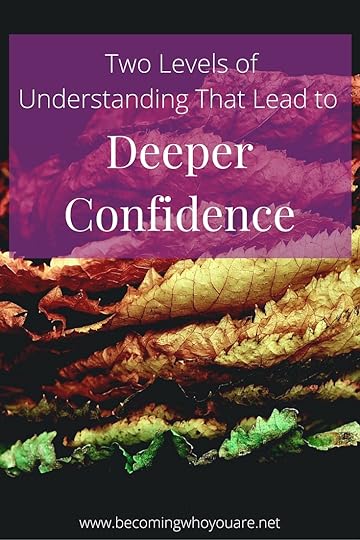
The post 95: Two Levels of Understanding That Lead to Deeper Confidence appeared first on Becoming Who You Are.










May 16, 2016
On Navigating the Minefield of Advice and Boundaries

I often receive requests for advice via email. It’s surprising and honouring that people choose to ask me rather than/as well as the many other personal growth writers out there. But it’s also sometimes based on a big misconception that, as a coach, giving advice is what I do (it’s really not).
In fact, I have an ambivalent relationship with advice. On the one hand, advice columns like Dear Prudence and Carolyn Hax are some of my guilty pleasures. I love reading people’s stories and I recognise the value in being able to ask about a specific issue and get a specific answer. A lot of the blog posts here (including this one) would be classed as advice. In certain situations, advice can help us get clarity, see a situation from a new perspective, and drag us out of a muddled fog with a clear path forward.
On the other hand, advice can be a minefield. The boundaries between the giver and the taker can often become muddied. Advice-givers can have their own, not always clear, agendas. In some situations, advice can leave us feeling more helpless than empowered. It’s often offered unsolicited (a personal pet peeve of mine) and it can make an unsatisfying substitute for simple compassion and understanding. Being able to show someone “I see you, I hear you, you are understandable and relatable,” is often a far bigger gift than telling them what you think they should do next.
When it comes to advice, caveat emptor.
With that in mind, in this (unashamedly advice-filled) post, I’m sharing a few thoughts I find helpful to remember when taking or asking for advice from others:
You have to live with the consequences, not the giver.
Whatever situation we’re in, when we take advice from someone, whatever happens next is our responsibility. If things don’t work out the way we had hoped that’s our responsibility. If we regret taking the advice that’s our responsibility. We don’t have a get out of jail free card that allows us to hold other person responsible for the consequences. We don’t get to come back to them later and say “Things didn’t work out and it’s your fault.”
Throughout six-ish years of being self-employed, I’ve taken advice from other people that has turned out to be not so great (for most of the following reasons). While it’s useful to acknowledge that with the gift of hindsight, I was still the one that acted on it. If I blame the advice-givers for the consequences, I’m far more likely to make the same mistakes over and over instead of learning from it and being more cautious next time.
Whenever we take advice, it’s a good idea to check the person’s credibility. Do they walk the walk as well as talking the talk? How’s that working out for them? Are they someone we like and trust? Are they coming at this with their own agenda (and if so, is that an agenda we can get behind?) Do they know enough about our situation to share a credible perspective?
What has worked for someone else in the past isn’t necessarily going to work for you in the present.
A lot of advice in the personal development world falls into the one size fits all category: “I used to be miserable, broke and lonely, and with this one amazing trick I turned it all around (P.S. if it doesn’t work for you, you’re obviously not doing it properly.)” That one amazing trick might well be helpful for that person, but it isn’t a guarantee it will work for everyone.
It’s important to be humble and recognise that we can learn a lot from people who are several steps ahead of us on the same path. Those people can inspire, motivate, and encourage us forward. But their way isn’t the be all and end all. It’s still our job to make the right decisions for us in the moment.
No one is the overriding authority on you, life or the universe.
I’m most tempted to take advice when I’m tired of struggling and I want someone to give me an easy solution, like, yesterday. And it’s the easy solution part that can be deceptively enticing. It’s OK to acknowledge we’re in a pickle and, right now, we can’t see the way out of it. We’ve all been there and sometimes there are no obvious right answers or easy resolutions to uncomfortable challenges or situations.
But there’s also a big difference between asking for help or support and asking someone else to take charge of our lives for us. As I mentioned above, we’re responsible for what happens next.
You know yourself best. You (and only you) can decide whether a particular piece of advice will work for you.
Advice isn’t always empowering.
Sometimes the path of least resistance is to turn to someone else and say “Tell me what to do! Fix this for me!” but when we do that, it’s usually because we’re embroiled in some kind of funky personal dynamic. We’re in victim mode and looking for a saviour. In the long-term, this just keeps us stuck, waiting for other people to come and rescue us. Instead, what I’ve needed most in these times is to pull on my adulting pants and recognise that, with the right guidance and support, I’m capable of figuring this out—no white knight required.
People are capable—often more capable than they give themselves credit for. That goes for you and me too. And we honour that capability by opening space for them to find the right answers for them, rather than imposing our own answers on them. This was something I learned during counselling training. It’s a philosophy I endeavour to carry through my coaching practice and in life too (admittedly, much easier said than done…)
Advice is often more about the giver than the receiver.
Sometimes advice can come from a well-meaning place, other times it can be rooted in ego. Advice can be based on what the other person believes is best for us, it can also be based on their own judgements, prejudices, and desire to “be right”. Even in the best case scenario, the advice giver is still bringing their own experiences, beliefs, histories and principles into the mix. Being truly disinterested is hard, if not impossible.
I know the times when I’m most desperate to give someone advice are the times when I most need to check that urge and ask: “Is this coming from a place of love and care for them? Or is this about me wanting to be perceived as useful and feel good about myself?”
Advice is a gift, not an obligation.
Click To Tweet
Whatever situation we’re in, advice is a gift, not an obligation. It’s something we are free to take or leave. It’s something we give best with a respect for the other person’s individuality, capability and strength. It’s also something we receive and consider with the same respect for ourselves.
When do you find advice most useful? And when is it better left unsaid? Leave a comment and share your thoughts.
Further reading: How to cultivate self-trust & other people’s choices don’t define whether we are good enough
Image: Kevin Curtis
The post On Navigating the Minefield of Advice and Boundaries appeared first on Becoming Who You Are.









May 11, 2016
A Visualisation for Deeper Confidence from Nathaniel Branden (& MP3)
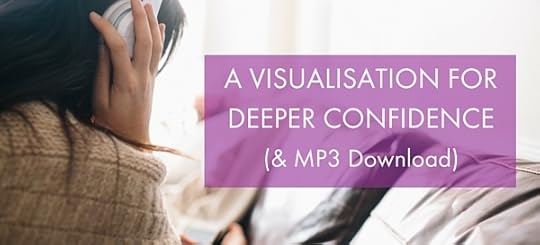
In this post, I want to share a visualisation based on a topic that is near and dear to most of us: confidence. This visualisation for deeper confidence is from the (excellent) book How to Raise Your Self-Esteem by Nathaniel Branden. In the book, he describes using it with a client to give her the experience of what confidence feels like.
When we know what a particular experience feels like physically and emotionally, we are better able to recreate that experience in the future. We have a reference point we can return to and we’re more likely to notice the thoughts, choices and behaviours that lead to those same feelings, and those that don’t.
When we use visualisation, we experience what it’s like to insert ourselves into a story. Rather than the usual internal stories in which we play a starring role—some of which are more helpful than others—this gives us a chance to take the lead in a different story and try that on for size.
What I love about this visualisation is it shows us we already have what we need to feel more confident and secure. We don’t need to add anything to our lives, we don’t need to become someone different, and we don’t need to start getting up at 5am to meditate.
A lot of it is about perspective.
You can find the (slightly adapted) text for the visualisation for deeper confidence below or, if you’d like to download an MP3 version to use as a guided meditation, you can do so from the Becoming Who You Are Library (not a member? Join for free here).
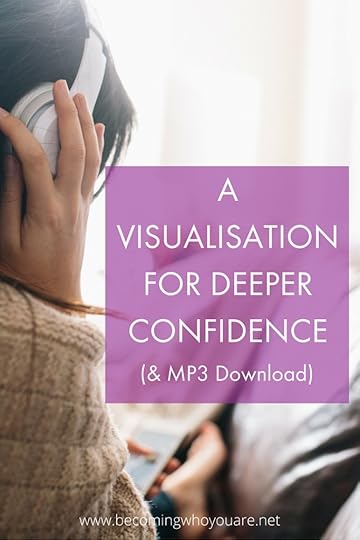
A Visualisation for Deeper Confidence by Nathaniel Branden
Close your eyes and shift your focus to your breathing. Take a few deep breaths. Imagine you are standing at the foot of a mountain, any kind of mountain you wish to create. There is a footpath leading up to the very top.
You begin to walk. You feel the pull on your leg muscles as you climb.
Are there trees and flowers on the side of this mountain?
As you climb, you become aware of something very interesting. All the fears and doubts and insecurities of your everyday life seem to fall away, like so much excess baggage you no longer need. The higher you climb, the freer you feel.
As you approach the top of the mountain, notice that you feel almost weightless. Your mind is clear. You feel stronger, more sure of yourself than you have ever felt in your life. Imagine this state and explore it. Do you like it? How does your body feel when you are self-confident and free of doubt and fear? …
Now you are just a few steps from the very top of the mountain. Now you stand on the top, looking out over the world.
How do you feel?
What is your sense of your relationship to the world now?
What is it like to be without the old familiar insecurities? Take a few minutes to explore that.…
And now turn and begin your descent back down the mountain. And as you follow the footpath down, notice whether you bring your new strength and freedom with you or whether you leave those feelings at the top of the mountain.
Do the old weights return as you approach the bottom?
As you come back to the point at which you started, can you look at the world from a new perspective?
How do you feel?
What changes?
Do you experience yourself differently?
When you’ve finished, spend a few minutes writing about your experiences, paying particular attention to the questions.
When we use visualisation, we experience what it’s like to live a different story.
Click To Tweet
How did you find the visualisation for deeper confidence? What did you notice? Leave a comment and share your thoughts!
Want the MP3 version of this visualisation? Download it from the Becoming Who You Are Library. If you’re not a member, you can get immediate access to this, plus 10+ other personal development tools for free. Enter your email below to access:
Email
*
Further reading: Let’s stop apologising for these things & How to stay optimistic when bad things happen
Image: Death to the Stock Photo
The post A Visualisation for Deeper Confidence from Nathaniel Branden (& MP3) appeared first on Becoming Who You Are.











